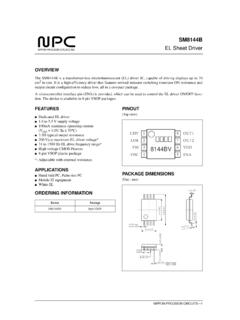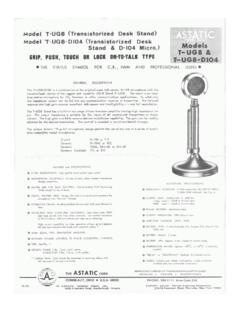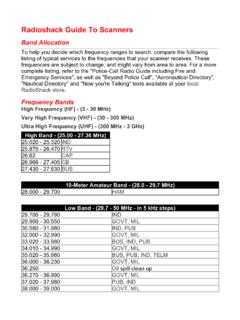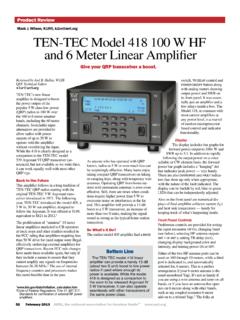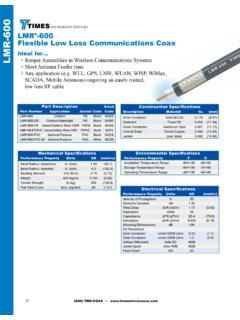Transcription of 959FR PG - CB Tricks - Home Page
1 - 1 - DX 959 TABLE OF CONTENTS CHAPTER 1 PAGE SPECIFICATIONS General.. 2 Transmitter.. 2 Receiver.. 2 CHAPTER 2 OPERATION Control & Connections.. 3 Front Panel .. 3 Rear Panel .. 6 Frequency Chart.. 7 Microphone.
2 8 Procedure To Receive .. 8 Procedure To Transmit .. 8 Alternate Microphones And Installation.. 8 CHAPTER 3 CIRCUIT DESCRIPTION Introduction .. 11 PLL Circuit .. 11 Receiver Circuit .. 11 Transmitter Modulation Circuit .. 11 Transmitter Amplifier Circuit .. 11 CHAPTER 4 ALIGNMENT Required Test Equipment.. 14 Alignment Procedures .. 14 PLL Alignment .. 14 Transmitter Alignment .. 15 Receiver Alignment .. 16 CHAPTER 5 MAINTENANCE Precautions .. 19 Periodic Inspection.
3 19 Fuse Replacement .. 19 CHAPTER 6 DIAGRAMS AND PART LIST PCB Layout & Part List.. 20 Updates and Corrections .. 33 CHAPTER 1 - 2 - DX 959 SPECIFICATIONS GENERAL Model DX 959 Frequency Range - Emission Modes AM/USB/LSB Frequency Control Phase Lock Loop (PLL) synthesizer. Frequency Tolerance %. Frequency Stability %.
4 Operating Temperature Range -30 C to +50 C. Microphone Plug-in dynamic; with push-to-talk switch and coiled cord. Input Voltage DC nominal 15%. Current Drain : Transmit (AM full mod.) < Current Drain : Receiver (Squelched) < (Max. audio output) < Antenna Connector UHF, SO239. Dimensions 2-3/8 (H) x 7-7/8 (W) x 9-1/4 (D). Weight 5 lb. TRANSMITTER RF Power Output AM : 4W SSB : 12W RF Transmit Modes AM/SSB Modulation High and low level Class B, Amplitude Modulation : AM and SSB Spurious Emissions -55 dB.
5 Carrier Suppression -55 dB. Audio Frequency Response 300 to 2500 Hz Antenna Impedance 50 Ohms. Output Indicators Meter shows relative RF output power, SWR and AM Modulation. Transmit LED glows red when transmitter is in operation. RECEIVER Sensitivity For 10dB S/N (AM) < V. Sensitivity For 10dB S/N (SSB) < V. IF Frequency AM : MHz 1st IF, 455 KHz 2nd IF. Image Rejection -65 dB. Adjacent Channel Selectivity -60 dB. RF Gain Control 45 dB adjustable for optimum signal reception. Automatic Gain Control (AGC) Figure Of Merit 100 mV for 10 dB Change in Audio Output Squelch Adjustable; threshold less than V.
6 Noise Blanker RF type. Audio Output Power 2 watts into 8 Ohms. Audio Frequency Response AM and SSB : 300 to 2500 Hz. Built-in Speaker 8 Ohms, round. External Speaker (Not Supplied) 8 Ohms; disables internal speaker when connected. (SPECIFICATIONS SUBJECT TO CHANGE WITHOUT NOTICE) DX 959 CHAPTER 2 OPERATION - 3 - Figure 2-1 Front Panel INTRODUCTION This section explains the basic operating procedures for the Galaxy DX 959 mobile transceiver. CONTROL AND CONNECTIONS FRONT PANEL Refer to the above Figure 2-1 for the location of the following controls. 1. SQUELCH CONTROL This control is used to control or eliminate receiver background noise in the absence of an incoming signal.
7 For maximum receiver sensitivity, it is desired that the control be adjusted only to the point where the receiver background noise is eliminated. Turn fully counter-clockwise, then slowly clockwise until the receiver noise disappears. Any signal to be received must now be slightly stronger than the average received noise. Further clockwise rotation will increase the threshold level which a signal must overcome in order to be heard. Only strong signals will be heard at a maximum clockwise setting. 2. ON/OFF VOLUME CONTROL Turn clockwise to apply power to the radio and to set the desired listening level.
8 3. MIC GAIN Adjusts the microphone gain in the transmit and PA modes. This controls the gain to the extent that full talk power is available several inches away from the microphone. In the Public Address (PA) mode, the control functions as the volume control. Pushing this knob turns the Roger Beep on and - 4 - off. When the Roger Beep is on, the radio transmits an audio tone at the end of your transmission. This indicates the end of your transmission so that people who are having trouble hearing you will know that you are done speaking. As a courtesy to others, use the Roger Beep only when necessary.
9 4. RF GAIN CONTROL This control is used to reduce the gain of the receive amplifier under strong signal conditions. 5. DIMMER CONTROL This knob controls the level of brightness for the meter lamp, the frequency display and the channel display. Also, pushing this knob turns the meter lamp and the display LED s on and off. 6. RF POWER CONTROL This control allows the user to adjust RF power output. 7. CHANNEL SELECTOR This control is used to select a desired transmit and receive channel. 8. FRONT PANEL METER The Front Panel Meter allows the user to monitor signal strength, RF output power, SWR level and AM modulation level.
10 9. TALKBACK CONTROL Pushing this knob turns the Talkback circuit on and off. Adjust this knob for desired volume of Talkback. This is used to monitor your own voice. For example, you could use this feature to compare different microphones. 10. CLARIFIER Allows tuning of the receive frequency above or below the channel frequency by up to KHz. Although this control is intended primarily to tune in SSB signals, it may be used to optimize AM signals . PWR SWITCH This switch controls the function of the meter during the transmit mode.



